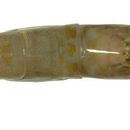Habitat
provided by Invertebrates of the Salish Sea
Rocky and muddy bottoms, may be more common on rocky bottoms.
- license
- cc-by-nc-sa
- copyright
- Rosario Beach Marine Laboratory
Distribution
provided by Invertebrates of the Salish Sea
Geographical Range: West side of Bering Sea and Sea of Okhotsk to Channel Islands off Santa Barbara, CA.
- license
- cc-by-nc-sa
- copyright
- Rosario Beach Marine Laboratory
Habitat
provided by Invertebrates of the Salish Sea
Depth Range: 5-1984 m
- license
- cc-by-nc-sa
- copyright
- Rosario Beach Marine Laboratory
Comprehensive Description
provided by Invertebrates of the Salish Sea
This moderately large shrimp has the multiarticulated carpus on its second pereopod and the long rostrum characteristic of Pandalids. Its first antenna is only about as long or slightly longer than its carapace. Abdominal segment 3 is not compressed and does not have a median dorsal ridge or mid-dorsal spine anterior to the posterior edge. The carapace has mid-dorsal spines only on the anterior half. The rostrum does not have mid-dorsal spines on the distal half, and it ends in three points. Abdominal segment 6 is about 3x as long as wide. Body color consists of fine red dots over a translucent background, with darker red background on distal rostrum, base of antenna, pleopods, side of sixth abdominal segment, and dorsal surface of uropods and telson. Up to 12.3 cm long.
- license
- cc-by-nc-sa
- copyright
- Rosario Beach Marine Laboratory
Look Alikes
provided by Invertebrates of the Salish Sea
How to Distinguish from Similar Species: P. platyceros has an abdominal segment less than twice as long as wide. P. eous, P. jordani, and P. goniurus don't have the steeply ascending rostrum with the three pointed tip. They also have a medial dorsal ridge on abdominal segment 3. This is the only pandalid shrimp in this area which has light bands on its legs but no stripes or spots on the body.
- license
- cc-by-nc-sa
- copyright
- Rosario Beach Marine Laboratory
Comprehensive Description
provided by Invertebrates of the Salish Sea
Biology/Natural History: This species was early identified as P. montagui tridens, a Bering Sea variation of the Atlantic P. montagui. However, the larvae differ in several reliable anatomic respects from those of P. montagui and the adults are colored differently, leading P. tridens to be given full species status. Except for the difference in coloration and the fact that the rostrum of P. montagui ends in 2 points and that of P. tridens ends in 3, the adults of these two species are almost indistinguishable. P. tridens tends to have more rostral spines but the counts overlap. P. tridens also has shorter dactyls than does P. montagui. The isopod Bopyroides hippolytes infests the gills of this species but does not infest P. montagui. It may also be parasitized by the Rhizocephalon barnacle Sylon hippolytes. This species is a protandroushermaphrodite. It appears to change from male to female at about 1 1/2 to 2 years old. In the Strait of Georgia females may be ovigerous from late November to early April.
- license
- cc-by-nc-sa
- copyright
- Rosario Beach Marine Laboratory

